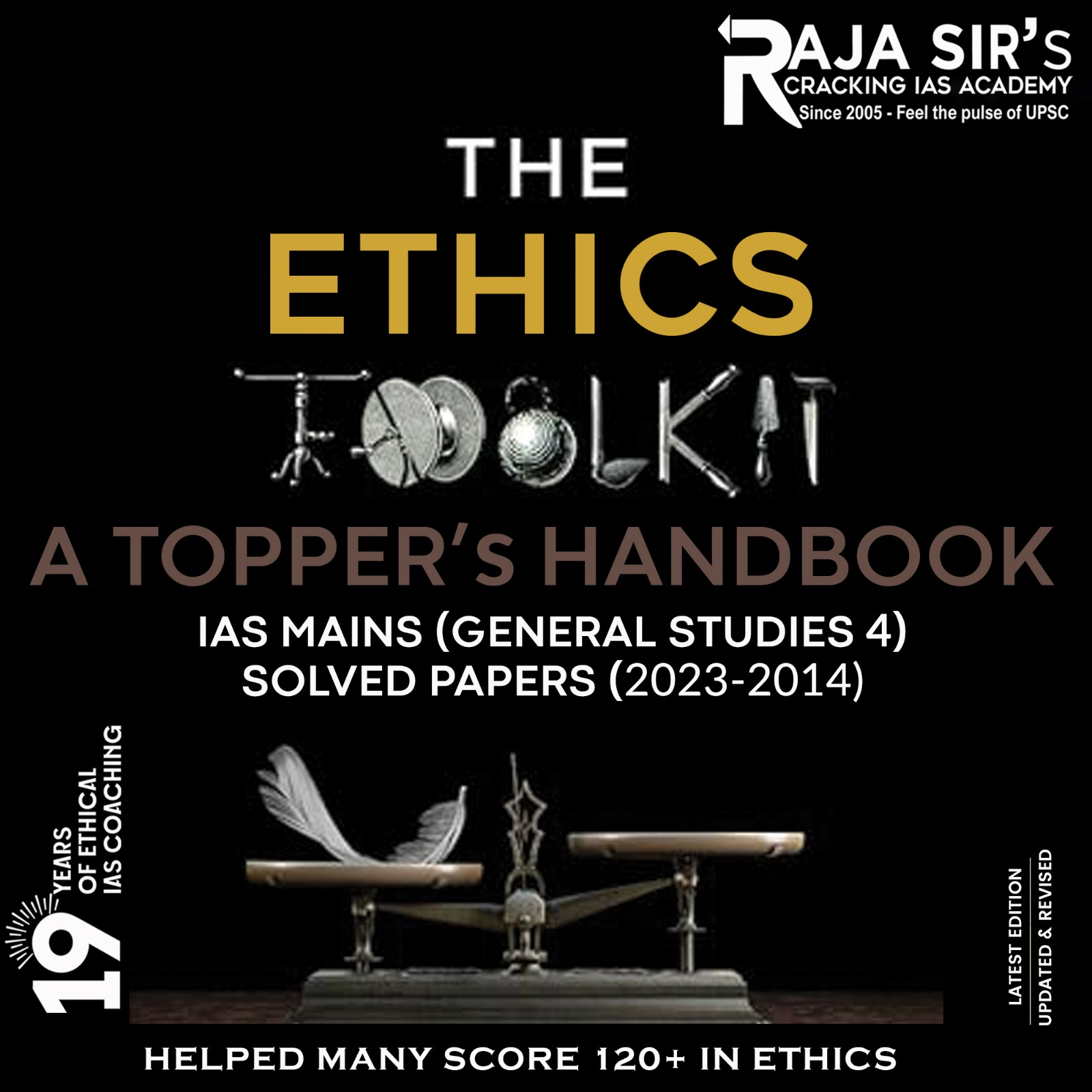- Home
- Prelims
- Mains
- Current Affairs
- Study Materials
- Test Series
 EDITORIALS & ARTICLES
EDITORIALS & ARTICLES
Hit List Questions 63-PPP 100 PRELIMS 2024 - 81
Questions & Explanations:
|
1. |
(1) Rare earth oxides include include the seventeen lanthanides on the periodic table. (2) Monazite is a mixed rare earth phosphate. Which of the above is/are incorrect?. (a) Only 1 (b) Only 2 (c) Both 1 and 2 (d) Neither 1 Nor 2
|
|
2. |
Anabranch of the Brahmaputra is (a) Kherkutia Xuti (b) Subansri (c) Padma (d) Bhoroli
|
|
3. |
Consider the following statements: 1. All locations north of the equator have days longer than 12 hours at the June solstice. 2. On the Antarctic Circle, there are 24 hours of nighttime on the June solstice. Which of the statements given above is/are correct?. (a) 1 only (b) 2 only (c) Both 1 and 2 (d) Neither 1 nor 2
|
|
4. |
Daylight saving time is the practice of advancing clocks during summer months by one hour. Why is Daylight saving time practice prevalent in many temperate countries?. 1. To increase the average working hours of the employees. 2. To conserve energy by utilizing the day light and reduce evening use of incandescent lighting. 3. To compensate is variation in day length experienced from season to season. (a) Only 1 (b) 2 and 3 (c) 1 and 3 (d) 1, 2 and 3
|
|
5. |
If the earth''s axis had not been inclined 1. temperature distribution would have been uniform 2. days and nights would not have occurred 3. seasons would not· have occurred 4. poles would not have continuous day (a) 1, 3 and 4 only (b) 2 and 4 only (c) 3 and 4 only (d) 2, 3 and 4 only
|
|
6. |
Most of the desert plants blooms during night time because (a) their blooming is controlled by low temperature (b) they are sensitive to the phases of moon (c) the desert insects eat away flowers during daytime. (d) the desert insects are active during nighttime
|
|
7. |
Soil Health Card is a printed report which contains nutrient status of soil with respect to (1) pH (2) Electrical Conductivity (3) Total Dissolved Solids (4) Boron (a) 1 and 4 only (b) 2, 3 and 4 only (c) 2 and 3 only (d) 1, 2 and 4 only
|
|
8. |
Consider the following statements w.r.t. gravitational waves: 1. Gravitational waves behave in similar fashion like electromagnetic radiation. 2. Gravitational waves are the ripples in the fabric of space-time as predicted by Albert Einstein. Which of the statements given above is/are correct?. (a) 1 only (b) 2 only (c) Both 1 and 2 (d) Neither 1 nor 2
|
|
9. |
The red colour in the sky at sunset (and sunrise) is due to (a) reddish-orange light is most scattered by the atmosphere. (b) reddish-orange light is least scattered by the atmosphere. (c) during that time sun emits only reddish-orange light. (d) during that time sun absorbs only reddish-orange light.
|
|
10. |
Volcanic eruption does not occur in the (a) Black Sea (b) Caspian Sea (c) Baltic Sea (d) Caribbean Sea |
|
11. |
Consider the following statements w.r.t. Clarion-Clipperton Zone: 1. It is in the van allen radiation belt. 2. It contains rare gases like radon in microscopic quantities. Which of the statements given above is/are correct?. (a) 1 only (b) 2 only (c) Both 1 and 2 (d) Neither 1 nor 2
|
|
12. |
Which of the following countries have more than one time zone?. (1) Russia (2) Canada (3) United States of America (a) Only 1 & 3 (b) Only 1 (c) Only 1 & 2 (d) 1, 2 & 3
|
|
13. |
Which of the following is/are Critically Endangered species?. (1) Pygmy hog (2) Gharial (3) Namdapha flying squirrel (a) Only 2 & 3 (b) Only 1 (c) Only 1 & 2 (d) 1, 2 & 3
|
|
14. |
Which of the following planet(s) that rotate from east to west? 1. Venus 2. Uranus 3. Saturn (a) Only 1 (b) 1 & 3 (c) 1 & 2 (d) 1, 2 & 3 |
|
15. |
Which of the following statements is not true? (a) Jet streams are positioned in the Troposphere. (b) Jet streams blow from west to east. (c) Jet streams cause rainfall in northwest India. (d) All the above are false.
|
|
16. |
Which of these is/are true?. 1. National parks in India are IUCN category II protected areas. 2. Biosphere Reserves of India are much bigger than national parks or wildlife sanctuaries. 3. ‘Conservation Reserves’ are uninhabited and completely owned by the Government of India. (a) 1, 2 & 3 (b) Only 3 (c) Only 1 & 2 (d) None of these
|
|
17. |
Which type of forest belt supplies most of the world''s requirement of newsprint?. (a) Coniferous forest (b) Deciduous forest (c) Evergreen forest (d) Mediterranean forest
|
|
18. |
“Yogyakarta principles” that were in news relate to (a) Principles of Theravada Buddhism (b) Inheritance of property (c) Yogic life (d) Sexual Orientation
|
|
19. |
1. Gulf type type of climate experiences a distinct dry period with a tendency towards a summer maximum. 2. China type of climate is characterized by a warm, moist summer and a cool, dry winter strongly influenced by maritime influence 3. The annual range of temperature is low and rain comes in prolonged showers in Natal type climatic regions. Which of these is/are correct?. (a) 1, 2 and 3 (b) 2 and 3 only (c) 1 and 3 only (d) 1 and 2 only
|
|
20. |
Consider the following statements: 1. The Tropic and Temperate Zones receive Orographic Rainfall. 2. Frontal rainfall is mainly associated with hail and graupel. Which of the statements given above is/are correct? (a) 1 only (b) 2 only (c) Both 1 and 2 (d) Neither 1 nor 2
|
|
21. |
Consider the following statements: 1. Duncan Passage is situated between South Andaman and Little Andaman 2. West of Duncan Passage is the Andaman Sea. Which of the statements given above is/are correct? (a) 1 only (b) 2 only (c) Both 1 and 2 (d) Neither 1 nor 2 |
|
22. |
Consider the following: 1. Long winter nights 2. Cloudless and clear sky 3. Dry air near the ground surface 4. Slow movement of air 5. Snow covered ground surface Which of the conditions given above produce “Temperature Inversion”? (a) 1, 2, 4 and 5 only (b) 1, 2, 3, 4, 5 (c) 1, 2 and 3 only (d) 1 and 2 only
|
|
23. |
Plastics with following Codes are considered safest to recycle. Identify them. I. 1 II. 2 III. 4 IV. 5 V. 7 (a) II, III, IV (b) I, III, V (c) I, II, III, IV (d) I & II
|
|
24. |
Subtropical high-pressure belts are otherwise called (a) Furious fifties (b) Screeching sixties (c) Horse latitudes (d) Roaring forties
|
|
25. |
Which of the following is not correct for inversion? (a) It causes the stability of the atmosphere. (b) It reduces visibility which causes disturbance in transportation. (c) It causes destruction of fruit orchards in the lower parts of valleys. (d) It results higher amount of precipitation.
|
EXPLANATIONS
|
1. |
· Monazite is a brown crystalline mineral consisting of cerium, lanthanum, other rare earth elements, and thorium. Monazite usually occurs in small, isolated crystals or grains that are resistant to weathering and become concentrated in soils. · In addition to the rare earth elements, thorium (Th) can be extracted from monazite ore. Thorium is a slightly radioactive metal, identical to uranium. Monazite is a major source of rare earths and thorium. It yields a number of rare-earth elements, such as neodymium and praseodymium. Both of these are in demand internationally for making high performance rare-earth magnets (components of power wind turbines, electric vehicles and robotics) · The Atomic Minerals Directorate for Exploration and Research (AMD), a constituted unit of the Department of Atomic Energy (DAE) has estimated the presence of 11.93 million tonnes of monazite resources in the beach sand mineral placer deposits along the coastal tracts of India. Though monazite is found in most coastal areas of India. It is questionable to be found along the entire coast. The main mines are found along the coasts of southern India in Kerala, Tamil Nadu, and in Orissa. · Monazite is a mineral mainly containing rare earths and thorium prescribed substance to be handled by the Department of Atomic Energy (DAE). Accordingly, Indian Rare Earths Ltd. (IREL) wholly owned by the Govt. of India, under the administrative control of the Dept. of Atomic Energy (DAE) utilizes monazite mainly for the production of rare earth compounds, and thorium, as needed in the Department of Atomic Energy |
B |
|
2. |
Ø An anabranch is a channel of water that leaves a river or stream and then rejoins again further downstream. An anabranch is considered to be part of the river or stream that it comes from. Ø Majuli is declared the largest river island in world by Guinness World Records. Ø It has been included in the tentative list of World Heritage Site by UNESCO Ø It is formed by Brahmaputra River in the south and Kherkutia Xuti, an anabranch of the Brahmaputra, joined by the Subansiri River in the north. Ø The island is inhabited by Mising tribes, Deori and Sonowal Kachri tribes Ø The people of the island speak Mising, Assamese and Deori language Ø Majuli is the birthplace of Vaishnava Satras. Shankaradeva, considered to be the Father of Assamese culture, had taken shelter in Majuli in 15th Century and spent a couple of months at Beloguri (West Majuli). He founded the first Vaishnava Satra at Majuli. The island is formed by the Brahmaputra River in the south and the Kherkutia Xuti, an anabranch of the Brahmaputra, joined by the Subansiri River in the north. These rivers usually bring fresh floods with heavy loads of fine silt and clay sediments. Majuli is purely a region of fluvial geomorphology. It rises from the Brahmaputra basin and in course of time turned into a flat-level alluvial plain. |
A |
|
3. |
C |
|
|
4. |
B |
|
|
5. |
C |
|
|
6. |
In desert conditions, most of the activity of the plants and animals happens during the night because of very high temperature in the day time. The desert insects make themselves active and pollinate the flowers at night. To attract the insects, most of the desert plants bloom during the night. |
D |
|
7. |
Soil Health Card Scheme The Ministry of Agriculture and Farmers’ Welfare introduced the scheme on December 5, 2015. Soil Health Card (SHC) is a printed report which contains nutrient status of soil with respect to 12 nutrients: pH, Electrical Conductivity (EC), Organic Carbon (OC), Nitrogen (N), Phosphorus (P), Potassium (K), Sulphur (S), Zinc (Zn), Boron (B), Iron (Fe), Manganese (Mn) and Copper (Cu) of farm holdings. SHC is provided to all farmers in the country at an interval of 3 years to enable the farmers to apply recommended doses of nutrients based on soil test values to realize improved and sustainable soil health and fertility, low costs and higher profits. Farmers can track their soil samples and also obtain their Soil Health Card report. It is a field-specific detailed report of soil fertility status and other important soil parameters that affect crop productivity. |
D |
|
8. |
Gravitational waves are fundamentally different from, for example, electromagnetic waves. The acceleration of electric charges creates electromagnetic waves, propagating in space and time. However, gravitational waves, created by the acceleration of mass, are waves of the spacetime ‘fabric’ itself. |
A |
|
9. |
A phenomenon called Rayleigh scattering causes light from the Sun to bounce off tiny particles in the atmosphere and scatter in different directions. Sunlight consists of many different colours: from red, which has the longest wavelength of all visible light, through to violet at the blue end of the spectrum, which has the shortest wavelength. Due to this short wavelength, blue light is scattered more effectively than other colours, and this is why the sky normally appears blue to us. At sunrise or sunset, however, when the Sun is low on the horizon, the light rays must pass through more of the atmosphere – and therefore bounce off more molecules – than at other times of day. This means that more blue light gets scattered away before the light reaches your eyes. Other colours – such as red, orange and yellow – can therefore continue to pass through the atmosphere unaffected, creating beautiful colours at the start and end of the day. |
B |
|
10. |
Volcanic eruptions do not occur in the Baltic Sea. In case of Baltic sea, the Baltic sea does not lie in between the tectonic plates but instead the basathic rock found in Baltic sea is transported by glacier so volcanic eruptions do not occur in Baltic sea. Sixty percent of all active volcanoes occur at the boundaries between tectonic plates. While the Caspian Sea itself does not have volcanic activities, it is a part of a larger region that includes the Caucasus Mountains to the west, which are situated on an active tectonic boundary, hence might have had some volcanic eruptions in the geological past. Caribbean Sea is known for its active seismic and volcanic activity because it lies on the edge of the Caribbean Plate. Although the Black Sea is not known for volcanic activity, it is surrounded by regions that have experienced historic seismic activity, including volcanic eruptions. |
C |
|
11. |
D |
|
|
12. |
D |
|
|
13. |
https://nagalandpost.com/index.php/2023/12/22/namdapha-flying-squirrel-sighted-in-arunachal/ |
D |
|
14. |
· ‘Venus’ is the second nearest planet to the sun. It is also called as ‘Earth’s Sister’ planet due to its similar size and mass as that of our Earth. It is the hottest planet in the solar system and experiences a mean surface temperature of 462C. It is popularly known as “Morning star and Evening star” It is seen in the east sky before sunrise (dawn) in the morning and in the west sky after the sunset (twilight). It rotates clockwise i.e. east to west direction on its own axis. The rotation and orbit of the Venus are unusual in several ways. Venus is one of just two planets that rotate from east to west. Only Venus and Uranus have this ‘backwards’ rotation. It completes one rotation in 243 Earth days which is the longest day of any planet in our solar system. The Venus takes 224.7 Earth days to complete one revolution around the sun, and it has no natural satellites. Venus is 0.7 astronomical units away from the sun. The sunlight takes 6 minutes to travel from the sun to Venus. |
C |
|
15. |
Jet streams · They are the fast flowing, narrow, and meandering air currents in the atmosphere of Earth. They generally are located near the altitude of the tropopause and are westerly winds (flowing west to east) due to the Coriolis Effect (movements of water and air currents induced due to the rotation of the earth). · An air current is a flowing movement of air within a larger body of air; they flow in the layers of air surrounding the Earth. They are formed due to the uneven heating of the Earth by the sun. As the warmed air expands due to heating it becomes lighter than the surrounding air; thus, it rises and creates a warm air current. Cooler and heavier air then steps in to replace the arisen warm air thereby forming a cool air current. Jet streams are the air currents found in the highest part of the atmosphere. Indian Monsoon Mechanism and the Role of SubTropical Jet Streams 1. The jet streams impact the onset of monsoon which depends upon the upper air circulation dominated by SubTropical Jet Streams (STJ). The south west monsoon in India is directly related to the tropical easterly stream. 2. The north east monsoon or more commonly called the winter monsoon is related to the subtropical westerly Jet Stream. It is a cold wind which pushes downwind to the surface thereby creating a high pressure on the surface. 3. Then the dry winds from this high pressure area which is in the north western part of India, start blowing towards the low pressure area or the Bay of Bengal. These winds are also responsible for the cold waves flowing in winter in the northern part of the country including UP and Bihar. 4. After reaching the Bay of Bengal, the westerly jet streams form the cause of north east monsoon and as this wind reaches the coast of Tamil Nadu, it causes rainfall due to the humidity received from the Bay of Bengal. · Jet streams are characterized by specific wind motions that are responsible for generating strong vertical shearing action, which is largely responsible for clear air turbulence. They are also one of the strongest winds in the atmosphere and their speed ranges from 129 to 225 kilometers per hour, but they can reach more than 443 kilometers per hour. They are relatively faster in winter due to the striking temperature differences between tropical, temperate, and polar air currents. |
A |
|
16. |
‘Conservation Reserves’ are uninhabited and completely owned by the Government of India but used for subsistence by communities. |
A |
|
17. |
Coniferous forests are the type of forest belt that supplies most of the world''s requirement of newsprint. Newsprint is a type of paper used for printing newspapers and other publications. Coniferous trees, also known as evergreen trees, are the primary source of the wood fiber used in newsprint production. Reasons why Coniferous Forests are the Primary Source: 1. Abundance of Coniferous Trees: Coniferous forests are characterized by an abundance of coniferous trees such as pine, spruce, fir, and cedar. These trees are rich in cellulose fibers, which are essential for the production of newsprint. 2. Long Fiber Length: The wood fibers from coniferous trees have a longer length compared to those from deciduous trees. Longer fibers are preferred for newsprint production as they provide strength and durability to the paper, enabling it to withstand the high-speed printing process. 3. High Pulp Yield: Coniferous trees have a higher pulp yield compared to deciduous trees. Pulp is the fibrous material obtained by breaking down the wood through a chemical or mechanical process. The higher pulp yield of coniferous trees makes them a more efficient and cost-effective source for newsprint production. 4. Suitable Fiber Properties: The wood fibers from coniferous trees have specific properties that make them well-suited for newsprint production. They have a lower lignin content, which is a complex organic polymer that can cause yellowing and brittleness in paper. Additionally, coniferous fibers have a higher tear strength, which is crucial for the rigorous printing and distribution process of newspapers. 5. Sustainable Management: Coniferous forests are often sustainably managed for timber production. Sustainable forestry practices ensure that trees are harvested responsibly, and new trees are planted to replace those that are cut down. This ensures a continuous supply of coniferous wood for newsprint production without depleting forest resources. |
A |
|
18. |
D |
|
|
19. |
https://iasgoogle.com/editorial/climate-and-its-characteristics |
A |
|
20. |
The Tropic and Temperate Zones receive Cyclonic or Frontal Rainfall, Conventional Rainfall is mainly associated with hail and graupel. |
C |
|
21. |
Duncan pass is located between South and little Andaman. Duncan Passage is a strait in the Indian Ocean. It is about 48 km (30 mi) wide; it separates Rutland Island (part of Great Andaman) to the north, and Little Andaman to the south. West of Duncan Passage is the Bay of Bengal; east is the Andaman Sea. |
A |
|
22. |
B |
|
|
23. |
A |
|
|
24. |
https://oceanservice.noaa.gov/facts/horse-latitudes.html
|
C |
|
25. |
· Inversion of temperature causes atmospheric stability which stops upward (ascent) and downward (descent) movements of air. The atmospheric stability discourages rainfall and favours dry condition. The inversion of temperature caused by the subsidence of air resulting in anticyclonic conditions increases aridity. This is why the western parts of the continents situated between 20°-30° latitudes and characterized by anticyclonic conditions represent the most widespread tropical deserts of the world. · Fog is formed due to the situation of warm air above and cold air below, and hence visibility is reduced which causes disturbance in transportation. · Valley inversion generally occurs in the mountainous valleys due to radiation and vertical movement of air. The temperature of the upper parts of the valleys in mountainous areas becomes exceedingly low during winter nights because of rapid rate of loss of heat from the surface through terrestrial radiation. Consequently, the air coming in contact with the cool surface also becomes cool. On the other hand, the temperature of the valley floor does not fall considerably because of comparatively low rate of loss of heat through terrestrial radiation. Thus, the air remains warmer than the air aloft and hence the warm and light air of the valley floor is pushed upward by the descending cold and heavier air of the upper part of the valley. Thus, there is warm air aloft and cold air in the valley floor and inversion of temperature is caused. This situation is responsible for severe frost in the valley floors causing great damage to fruit orchards and vegetables and agricultural crops whereas the upper parts of the valleys are free from frost. This is why the valley floors are avoided for human settlements while the upper parts are inhabited in the mountainous valleys of middle latitudes. · Convection clouds can not move high upwards so there is less rainfall and no showers. So, it causes a problem for agricultural productivity. · A problem with temperature inversions is that pollution can gather under the inversion. Temperature inversions occur when warm air is trapped above cool air, preventing the normal mixing of the atmosphere. This can lead to a buildup of pollutants, such as smog and particulate matter, in the lower layers of the atmosphere. For example, in cities surrounded by mountains, temperature inversions can trap pollution in the valleys, resulting in poor air quality. |
D |









 Latest News
Latest News




 General Studies
General Studies